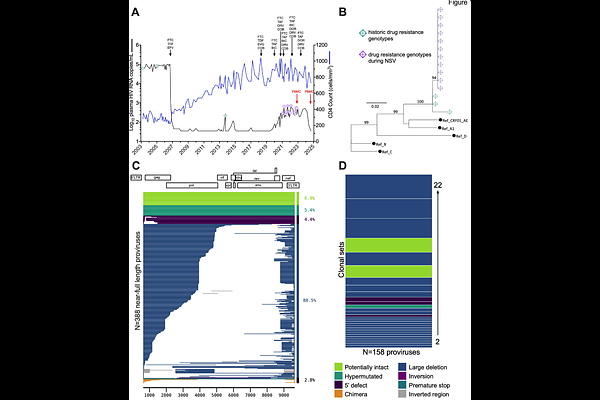Prolonged non-suppressible viremia sustained by a clonally expanded, genomically defective provirus with an immune-evasive HIV protein expression profile

Prolonged non-suppressible viremia sustained by a clonally expanded, genomically defective provirus with an immune-evasive HIV protein expression profile
Omondi, F. H.; Sang, Y.; Mwimanzi, F.; Cheung, P. K.; Derza, Z.; Dong, W.; Barad, E.; Anderson, K.; Mysak, V.; Lima, V. D.; Hull, M.; Brumme, C. J.; Harris, M.; Montaner, J. S. G.; Guillemi, S.; Brockman, M. A.; Brumme, Z. L.
AbstractAntiretroviral therapy (ART) potently inhibits HIV replication but does not eliminate HIV proviruses integrated within the genomes of infected cells. Though ART normally suppresses HIV to clinically undetectable levels in blood, some individuals experience non-suppressible viremia (NSV) that is not attributable to suboptimal drug exposure (e.g. due to incomplete medication adherence or pharmacological issues) nor emerging HIV drug resistance, and that does not resolve following regimen modification. We now understand that NSV can originate from expanded cell clones harboring genetically identical proviruses that reactivate en masse to produce clinically detectable viremia. NSV can even originate from proviruses with genomic defects, particularly in HIV\'s major splice donor (MSD) site, that render the viremia non-infectious. But, because only a limited number of such cases have been described, all in HIV subtype B, the mechanisms that allow cells harboring such proviruses to produce prolonged viremia without being eliminated remain incompletely understood. We characterized a case of MSD-defective, replication-impaired NSV that lasted >4 years in an individual with non-B HIV. Our results reveal that proviruses with MSD deletions can persist by integrating into minimally differentiated CD4+ T-cell subsets that then give rise to the full spectrum of memory and effector subpopulations, and by exhibiting an HIV protein expression profile that would allow these cells to evade cellular and humoral immunity. Our results highlight the need to better understand the biological implications of persistent HIV protein and virion production by genomically defective, clonally expanded proviruses, and for clinical guidelines to acknowledge this type of viremia.